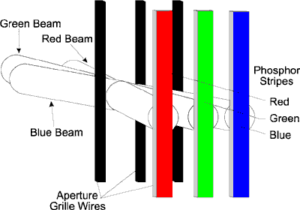Before the three-gun, shadow mask CRT was firmly established as a standard for producing colour CRTs, several other novel systems were developed.
One of these was the PDF (Post Deflection Focusing) Chromatron developed at the University of California. This tube had a single electron gun addressing a pattern of continuous vertical phosphor stripes on its faceplate. As the name suggests, the beam of electrons in this CRT were focused on the required red, green or blue phosphor stripe by electrodes which the beam encountered after it had passed beyond the influence of the deflection yoke. These electrodes were mounted less than half an inch from the phosphor-coated faceplate and took the form of a series of vertically-oriented parallel wires. By altering the way current flowed through pairs of these electrodes, the electron beam could be made to pass directly between them or be deflected slightly to left or right and so made to strike the desired colour of phosphor stripe. The Chromatron was produced by Sony in the early 1960’s but was dropped after a short while because of manufacturing difficulties.
In 1968, however, Sony introduced the Trinitron tube which also uses a single electron gun and a vertically aligned series of wires mounted close to the CRT’s faceplate. Unlike the Chromatron, the Trinitron’s single gun produces three separate electron beams, one for each phosphor stripe. Consequently, it has no need to use the array of wires as electrons. Why, then, use these wires, which Sony calls an aperture grille, if they are not needed as electrodes? Sony found that the arrangement of wires and phosphor stripes meant a greater number of electrons reaching the phosphor, which covers more of the screen area, leading to a brighter picture and better colour purity. Sony also found a reduction in the moiré patterning found in shadow mask tubes. The one gun three beam approach also meant tighter focus for higher beam currents.

